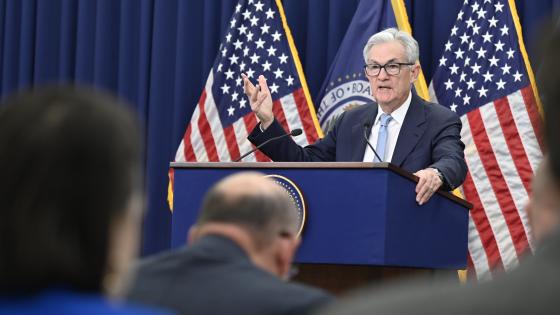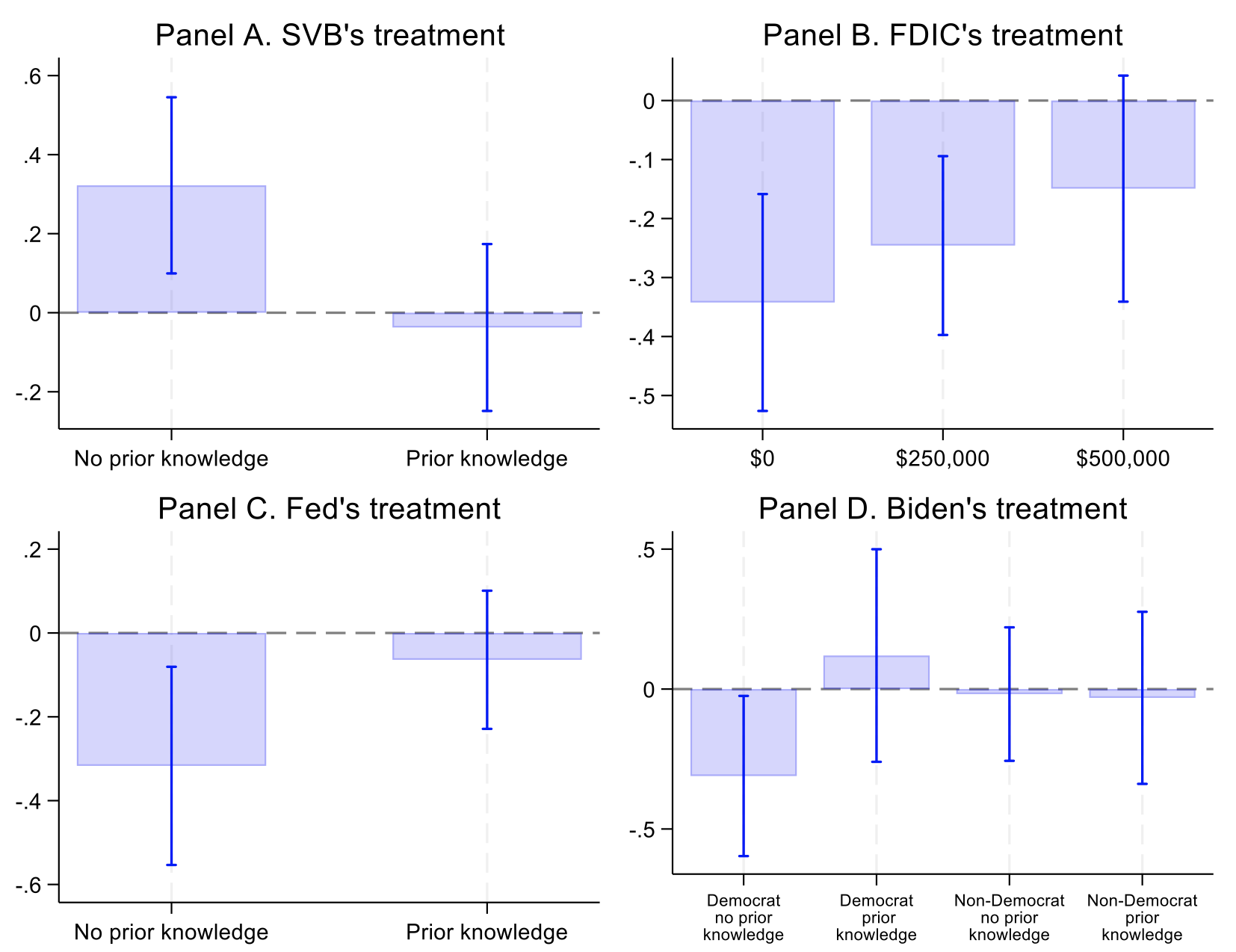On 9 March 2023, Silicon Valley Bank (SVB) suffered a major bank run, with deposit outflows of over $40 billion, causing the bank to become insolvent. This event cast doubts on the stability of the US banking sector and raised concerns that panic could spread among depositors, triggering other bank runs. To alleviate these concerns, President Biden addressed the nation on the morning of Monday, 13 March to reassure depositors about the solidity of US banks. A few days later, Federal Reserve Chair Jerome Powell opened the Federal Open Market Committee (FOMC) press conference by expressing confidence in the US banking sector.
To what extent does the collapse of a large bank such as SVB increase the risk of panic-driven runs? And can public communication by politicians or central banks lean against such risk? To address these questions and gain a general understanding of how US households perceive bank and deposit risks, our recent paper (Sandri et al. 2023) examines the results of a survey conducted in the aftermath of the SVB collapse.
Survey structure
The survey was conducted by YouGov on a sample of about 6,000 US households and was launched at the end of April 2023, gathering a wide range of information on people’s perceptions about bank and deposit risk. To identify the causal effects of news about SVB and policy communication on people’s propensity to withdraw their bank deposits, the survey used randomised controlled trial (RCT) techniques based on information treatments. Similar approaches have been used successfully in a recent but rapidly growing literature to examine, for example, the factors influencing the inflation expectations of households and firms (e.g. Gorodnichenko et al. 2019, Schoenle et al. 2020, Grigoli and Sandri 2023), or households’ consumption decisions (Gorodnichenko et al. 2021). Our study is the first to use these survey techniques to shed light on people’s perceptions and reactions to deposit risk.
Specifically, survey participants were divided into four treatment groups and one control group. The four treatment groups were provided with information about the SVB collapse, statements by either President Biden or Chair Powell expressing confidence in the US banking sector, and information about the Federal Deposit Insurance Corporation (FDIC) to assess its role in reassuring depositors. The survey collected information about respondents’ ‘propensity to run’ – that is, to withdraw deposits because of concerns their bank may fail – before and after the treatments. The analysis examines whether the information treatments generate revisions in the propensity to run compared to the control group, which is provided with no information.
News about SVB increases the risk of bank runs, but public communication can help
Figure 1 illustrates the key results of the analysis. Panel A shows that the information treatment about SVB’s collapse increases the propensity to run among survey participants that did not already know about SVB. As expected, the SVB information treatment has no effect on people with prior knowledge about the bank. To provide a quantitative interpretation of these findings, the survey also included questions to assess how households would reallocate their portfolio in the face of bank risk. By leveraging these answers, we find that the SVB information treatment triggers a reduction in bank deposits by about 2.5%. According to our survey data, only about one-third of US households heard about SVB, so our results predict deposit outflows from the US banking sector of about 0.8% following the SVB collapse. This estimate is remarkably close to actual deposit drawdowns in the days following SVB’s demise, which amounted to 0.7% between 8 and 15 March, 2023.
Figure 1 Information treatment effects on households’ propensity to run
Notes: Figure 1 shows the impact of each information treatment on households’ propensity to withdraw their deposits because of concerns their bank may fail. Bars show point estimates while whiskers show 90% confidence intervals. The labels ‘prior knowledge’ in panels A, C, and D denote people with prior knowledge about the information presented in each treatment. In Panel B, dollar amounts on the x-axis denote people’s priors about the FDIC insurance limit on individually held accounts.
Panel C shows that communication by the Fed information treatment reduces households’ propensity to run among people with no prior knowledge about the Fed’s pronouncement. Interestingly, the quantitative impact of the Fed treatment offsets the impact of news about SVB. Panel B shows that information about FDIC insurance can also reduce households’ propensity to run, especially among people who think that deposit insurance thresholds are very low or nil. Hence, communication by the Fed and information about deposit insurance emerge as a potentially powerful tools to reassure depositors and prevent panic-driven bank runs.
In contrast, the information treatment based on President Biden’s statement had a more limited reach. This treatment reduces the propensity to run only among Democrats, the president’s electoral base. This underscores the limits of political communication – even by the top government officials – in the current environment of strong political polarisation.
Challenges for policy communication
The analysis provides encouraging insights about the effectiveness of policy communication in preventing bank runs. Yet key challenges remain. First, for policy communication to be effective, it must reach people¬ – not an easy task in an era when people are bombarded by information of all types across multiple media platforms. Indeed, our survey reveals that only about one in five people had heard about the Fed’s assurances regarding the banking sector or knew about the correct FDIC insurance threshold on deposits. Second, by differentiating people along socio-economic characteristics, we find evidence that policy communication tends to reassure people who are not necessarily more responsive to news about SVB. Hence, a large bank failure can still spark bank runs among segments of the population who appear insensitive to public communication. Further research is needed to examine this type of heterogeneity. Third, our results show the limits of political communication, which seems to resonate only within party lines. This underscores the need for the political system to provide more consistent, bipartisan messages if it wants to influence the public at times of crisis.
Authors’ note: The views expressed herein are those of the authors and should not be attributed to the BIS.
References
Sandri, D, F Grigoli, Y Gorodnichenko and O Coibion (2023), “Keep Calm and Bank On: Panic-Driven Bank Runs and the Role of Public Communication”, NBER Working Paper 31644.
Grigoli, F and D Sandri (2023), “High public debt levels raise household inflation expectations – but central banks aren’t powerless”, VoxEU.org, 13 April.
Gorodnichenko Y, M Weber and O Coibion (2021), “How inflation expectations affect households’ spending decisions”, VoxEU.org, 19 March.
Gorodnichenko Y, T Ropele and O Coibion (2019), “Firms' expectations of inflation matter: New evidence”, VoxEU.org, 5 March.
Schoenle R, Y Gorodnichenko, E Knotek and O Coibion (2020), “Average inflation targeting and household expectations”, VoxEU.org, 30 September.









